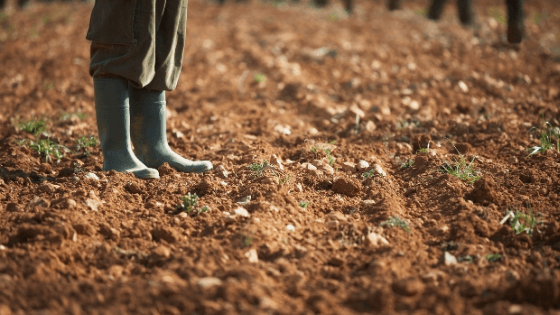Share this
Soil, a Living System
by Naz Hatay on 23/Apr/22
Soil and dirt are not synonymous with one another. Dirt is infact displaced soil. (2). J.L. Anderson, the writer of Industrializing the Corn Belt: Agriculture, Technology, and Environment explains dirt “from the perspective of the people who raised the crops and livestock…the farmer ‘with the dirt on his hands and dung on his boots’”(3).
When cut off from its ecosystem, subsequently losing its functionality, the soil turns to dirt and becomes no longer a productive member of the society. In order for soil to be productive, it has to stay alive and it has to remain healthy.
There are many definitions in the literature that define the term soil health. The FAO describes soil as: “the capacity of soil to function as a living system”. Healthy soils are important for crop production because they can help control plant disease, pests, and improve soil structure. (4).

Before going further into soil health, subsequently agricultural productivity, soil functionality must be covered first. Soil is essential for plant growth, providing water and nutrients, purifying the air, and stabilizing the ground. It also plays an important role in regulating the Earth's atmosphere.
Healthy soil means cleaner air and water, fertile and rich crops and forests, productive pastures, and diverse wildlife. In other words, “better soil, better food, better life”. For soil to be considered healthy, it needs a rich and diverse living community: macrofauna such as nematodes, arthropods, and mollusks, and microorganisms such as bacteria, archaea, fungi, and protozoa. The second group, formed by tiny creatures living underneath the ground, is defined as the soil microbiome.
These microorganisms carry out a range of processes important for soil health and fertility in soils of both natural ecosystems and agricultural systems, one of which is to transform organic matter into plant nutrients, along with converting the soil minerals into disease-suppressing compounds (5)(6).
Soil, as mentioned earlier, can regulate Earth’s atmosphere by fixing atmospheric gases, such as carbon dioxide among others. However, the soil can’t do that without its living part, the soil microbiome.
To explain the carbon cycle in figures, the total carbon in terrestrial ecosystems is approximately 3170 gigatons. Of this amount, nearly 80% is found in soil (7). Releasing just 0.1% of the carbon in Europe's soils would be the equivalent of annual emissions from 100 million cars. (8).
In addition to carbon dioxide storing capacity, soil also plays a crucial role in balancing other greenhouse gases, such as nitrous oxide and methane. Nitrous oxide is almost 300 times more potent, and methane is about 20 times stronger than carbon dioxide (9). A major direct source of nitrous oxide is synthetic fertilizers.
Intensive farming practices that use nitrogen-based fertilizers can pollute the air and water, and disrupt the ability of the soil to cycle carbon and nitrogen.This mention of the soil’s cycling and storage of carbon brings us to the term carbon sequestration.
“Carbon sequestration is the process of capturing and storing atmospheric carbon dioxide. It is one method of reducing the amount of carbon dioxide in the atmosphere with the goal of reducing global climate change.”(10). One of the areas where one can see significant negative consequences of climate change is biodiversity.
In recent years, the interconnection of climate change and biodiversity has been widely recognized. But what is not known to many is the significant impact of climate change on all the soil biodiversity and related services.
Soil biodiversity also referred to as the “factory of life” by the EU Commission in their report about soil biodiversity (11), plays an important role within the global system, because through microorganisms, soil can mitigate climate change, and store greenhouse gases, purify water and prevent erosion. Soil biodiversity is essential for healthy soil, which in turn is necessary for producing healthy food and sustaining life. (12),
To conclude, the interconnected nature of ecosystems is an undeniable fact that lay in front of us. Ending with a quote “Soil is at the bottom of the food chain, yet it is the cornerstone of life on earth.”
Are you interested in Soil Health?
Download our ebook
Bibliography
(1) Food and Agriculture Organization:
http://www.fao.org/3/a-au887e.pdf
(2) Hans, Jenny. Factors of Soil Formation, A System of Quantitative Pedology
(3) Gardner, Madelyn. Soil Ain’t Dirt: The Many Meanings of Soil in the Lives of Iowa Farmers:
https://www.grinnell.edu/sites/default/files/documents/madelyn_gardner_soil_aint_dirt.pdf
(4) Food and Agriculture Organization:
(5) Food and Agriculture Organization:
http://www.fao.org/3/a0100e/a0100e0d.htm
(6) Schlatter Daniel, Kinkel Linda, Thomashow Linda, Weller David, Paulitz Timothy. Disease Suppressive Soils: New Insights from the Soil Microbiome. The American Phytopathological Society, Phytopathology:
https://apsjournals.apsnet.org/doi/10.1094/PHYTO-03-17-0111-RVW
(7) Ontl, T. A. & Schulte, L. A. (2012) Soil Carbon Storage. Nature Education Knowledge 3(10):35:
(8) European Commision, Soil the hidden part of the climate cycle:
https://ec.europa.eu/clima/sites/clima/files/docs/soil_and_climate_en.pdf
(9) ibid 8.:
https://ec.europa.eu/clima/sites/clima/files/docs/soil_and_climate_en.pdf
(10) USGS, Science for a changing world. What is Carbon Sequestration:
(11) European Commision, The factory of life
Why soil biodiversity is so important:
https://ec.europa.eu/environment/archives/soil/pdf/soil_biodiversity_brochure_en.pdf
(12) Farm Advisory Service, Soil Biodiversity and Soil Health:
https://www.fas.scot/downloads/tn721-soil-biodiversity-and-soil-health/
Originally published December 1, 2020, updated April 23, 2022.
Share this
- June 2025 (2)
- September 2024 (1)
- August 2024 (1)
- July 2024 (1)
- June 2024 (2)
- May 2024 (2)
- April 2024 (2)
- March 2024 (1)
- February 2024 (1)
- January 2024 (1)
- November 2023 (1)
- October 2023 (1)
- September 2023 (1)
- August 2023 (2)
- July 2023 (2)
- May 2023 (2)
- April 2023 (3)
- March 2023 (3)
- February 2023 (2)
- January 2023 (1)
- November 2022 (1)
- October 2022 (2)
- September 2022 (1)
- August 2022 (3)
- July 2022 (3)
- June 2022 (1)
- May 2022 (5)
- April 2022 (7)
- August 2021 (1)
- July 2021 (1)
- May 2021 (1)
- April 2021 (4)
- November 2020 (3)
- October 2020 (4)
- September 2020 (1)
- August 2020 (3)
- July 2020 (1)
- June 2020 (1)
- May 2020 (2)
